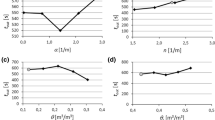Conclusions
-
1.
The engineering personnel of the trust Gidromekhanizatsiya and experimental industrial enterprise Promgidromekhanizatsiya were able to develop an optimal hydraulic transport performance indicator (OHTPI-2) based on monitoring the soil sediment layer in a pipeline and consistency of the soil—water mixture by the conductometric method.
-
2.
The installation of the OHTPI-2 on a dredge makes it possible to inform the operator about attaining and maintaining optimal saturation of the mixture with soil for the given concrete conditions. An increase of productivity and reduction of energy expenditures by 18% were achieved during the test. For effective use of the indicator it is necessary to instruct the dredge personnel in the rules of operating the device and selecting the dredging regime.
-
3.
By means of the indicator it is possible to check the optimality of the existing parameters of hydraulic transport — head, flow rate, and diameter of the pipeline and their correspondence to the particular soil conditions.
-
4.
The indicator of the soil sediment level in the pipeline can be used for monitoring the soil level and liquid phase in a vessel.
-
5.
It is necessary to continue works on improving the indicator for its combination with other monitoring and calculating instruments.
Similar content being viewed by others
Literature cited
G. D. Kalinina, Hydraulic Transport of Soils with Partial Clogging of the Pipeline, Author's Abstract [in Russian], MISI (1953).
A. P. Yufin, Hydraulicking [in Russian], Stroiizdat, Moscow (1974).
M. Gromov, E. Zorin, and V. Matokhin, “The ‘Sloi’ automation system,” Rechnoi Transport, No. 9 (1967).
V. Ya. Koretskii and A. B. Relin, Methods and Devices for Automatic Monitoring of the Consistency of Pulps of Dredging Plants [in Russian], TsNIÉIugol., Moscow (1982).
A. B. Relin, Creation and Operation of Modern Systems Automaically Monitoring the Output of Dredges at Mine Workings [in Russian], Nedra, Moscow (1984).
G. A. Nurok, Technology and Designing of Hydraulicking of Mining Operations [in Russian], TsP NTGO, Moscow (1965).
N. N. Kozhevnikov, G. Ya. Speranskii, and G. D. Temnikov, “Conductometric consistometer of pulp in a pipeline,” USSR Inventor's Certificate No. 1416618, Otkrytiya. Izobret., No. 30 (1988).
N. N. Kozhevnikov, G. Ya. Speranskii, and B. V. Ukhin, “Method of calibrating an indicator of clogging a pipeline by soil,” USSR Inventor's Certificate 1409731, Otkrytiya. Izobret., No. 26 (1988).
Efificient Dredging. LHC Dredging Instruments and Controllers, LHC Holland (1988).
Additional information
Translated from Gidrotekhnicheskoe Stroitel'stvo, No. 6, pp. 10–15, June, 1989.
Rights and permissions
About this article
Cite this article
Kozhevnikov, N.N., Kiselev, V.I., Speranskii, G.Y. et al. Development and introduction of the OHTPI-2 optimal hydraulic transport performance indicator. Hydrotechnical Construction 23, 312–318 (1989). https://doi.org/10.1007/BF01424065
Issue Date:
DOI: https://doi.org/10.1007/BF01424065



